If you are drawn to striking martial arts, few offer the dynamics and excitement of kickboxing. As the name suggests, it includes boxing and kicking, which may be too broad a description. Many full-contact martial arts, like Muay Thai, Savate, and Sanda, fall under the kickboxing category.
Then there are light contact and point fighting styles, also considered kickboxing. But what most people refer to when they talk about kickboxing today is the K-1 style, which is a full-contact ring combat sport with punches, kicks, and knees.
This kickboxing style has been influenced by boxing, Muay Thai, karate, and many others to become what it is today.
Competitions like those held by Glory and One FC are high-paced, stand-up fighting at its finest, with few options to stall the action like clinching and grappling. If that fighting style excites you, kickboxing is the right pick for you.
But before you even think about getting into the ring, you must first learn many things. Sweet Science of Fighting is here to take you through the initial steps in your kickboxing journey.
Discover The Little Known Secrets For Unlocking Devastating KO Power!
Heavy hands are built doing these things...
How To Start With Kickboxing
The best thing you can do is to find a convenient gym and start training there. Training under supervision and with training partners is invaluable and cannot be fully substituted with anything.
With that said, as a beginner, you will do hours of solo drills anyway to familiarize yourself with the basic techniques and ingrain them in muscle memory. An excellent way to do that is to delegate some training to your home to speed up the learning process.
Going through instructional guides, watching videos, and watching fights is mandatory to learn all the strikes, movement patterns, tempo, and specifics of kickboxing fights.
However, this is not to say that you must first learn everything before signing up for an actual gym. This guide and solo training are excellent ways to supplement gym training, not replace it.
You can practice each move separately at home, beginning with the stance, then moving on to footwork, punches, and kicks. Start combining them once you feel comfortable until you start shadowboxing, which means mimicking an actual fight or sparring.
Stance and Footwork
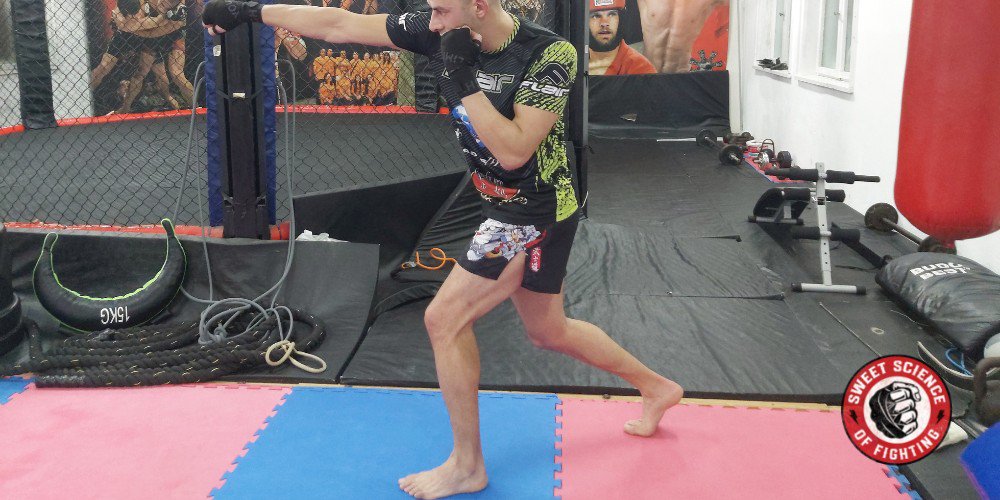
It all starts with the stance. Different fighting styles use different variations of the stance. Still, beginners should always start by mastering the basic one and then mold it to their own style. Here is how it looks for orthodox (right-handed) fighters.
- The left foot is forward one step.
- The feet are shoulder-width apart. The left foot points forward, and the right at around 45 degrees. The weight is more on the balls of the feet.
- Hands are held high, elbows are tucked in, the left hand is slightly forward, and the right stays close to the head.
- The chin is tucked with the eyes on the opponent.
In kickboxing, the weight is usually slightly more on the back leg. This allows the lead leg to kick and lift to check a kick faster.
This is very pronounced in the classic Muay Thai stance, where the front foot barely touches the floor, and about 80% of the weight is on the back. For a more boxing-heavy style, you can lean more on the front, giving power to your punches, but taking it away from your front leg kicks.
Standing still will get you nowhere in the kickboxing ring, which is why footwork is essential. It may not be as crucial in boxing, but it’s still imperative as it ties everything together.
Proper footwork and positioning are key to landing punches and kicks on a moving opponent and maintaining good balance when defending. The main thing about beginner kickboxing footwork is that you must always try to keep your stance intact.
Kickboxing has three main movement patterns: forward and backward, lateral, and pivoting. As a rule, every move in a particular direction should start with the corresponding leg.
Or in other words, when moving forward or left, you first move your left foot, and when moving backward and to the right, you lead with the right foot.
Forward- Move your left foot forward, pushing off the right foot. Then slide the right foot forward.
Backward– Push off your led left leg and move the right foot backward, then slide the left into position.
Left– Step to the left with the left foot and slide the right into the basic stance.
Right- Step to the right with the right foot and then slide to the left.
Here are the main things that you must look out for:
- When one foot moves a certain distance, the other moves the same distance.
- Once you finish moving, you should always end up in the basic stance
- Keep the weight balanced roughly 60/40 in favor of the back leg.
- Stay light on your feet; both legs should be slightly on the toes.
- Never cross your legs.
- Don’t stand straight up; you need a slight bend in the knees.
Boxing For Kickboxing
As seen from its name, kickboxing takes its punches from boxing. As a ring sport practiced with boxing gloves, all the punches from boxing are allowed and function just the same in kickboxing.
The only difference is that they can be linked with kicks in combinations. There are six basic punches found in boxing. Each has variations, but as a beginner, you should first master the basics.
Jab
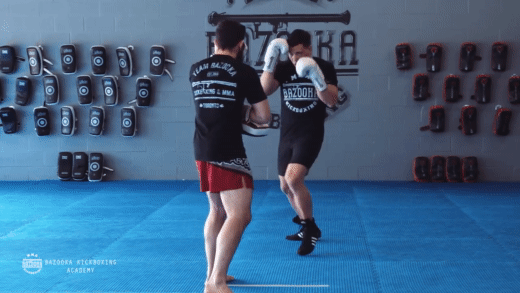
Go to how to throw a jab for an in-depth breakdown. But here is a quick summary:
- The jab is a straight shot with the lead hand.
- It has great utility and can be used as a range finder, as a setup for other punches, or to deal damage.
- In boxing, the jab is the longest weapon. However, in kickboxing, the kicks take that function, so while a jab is still very important, it’s not the most critical strike in the arsenal.
Cross

Learn how to dominate opponents with the cross by going to how to throw a cross. Here’s a quick breakdown:
- The cross is a straight punch with the rear hand.
- It is a punch that can generate a lot of power and has an excellent range.
- The key to a good cross is engaging the whole body into the punch in a single fluid motion, starting from the feet through the torso and ending with the fist.
Hooks
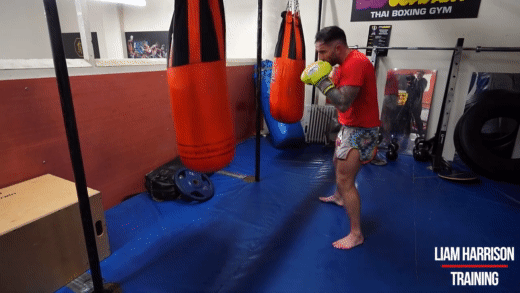
Be able to demolish opponents with powerful hooks by going to how to throw a hook. Here’s a quick breakdown:
- The hook is a horizontal punch with an arm bent at 90 degrees angle. It can be both a lead or a rear.
- Hooks are very powerful but have a shorter range than straight punches
- The power is again generated from the legs and torso, with the arm adding very little force
Uppercuts
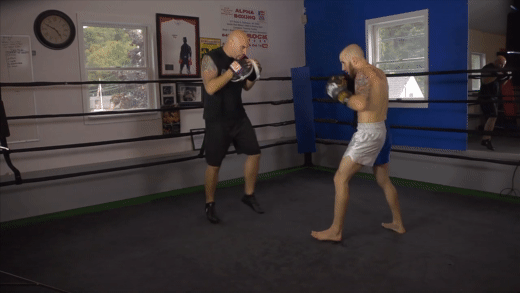
Learn the ins and outs of a good uppercut by going through how to throw an uppercut. Here’s a quick breakdown:
- Uppercuts are punches flying in a vertical upwards motion and can be thrown with the lead and the rear hand.
- Uppercuts are extremely powerful but have a short range, leaving you more open to counterattacks.
Kicking For Kickboxing
Kicks in kickboxing are a lot more varied than punches. There are different kicking styles, ranging from powerful shin kicks in Muay Thai to flying and spinning stuff found in Taekwondo.
But it’s better to stick to the basic straight and round kicks for now. They are more than enough; even some world-champion kickboxers use only these basic kicks in their game.
Front Kicks
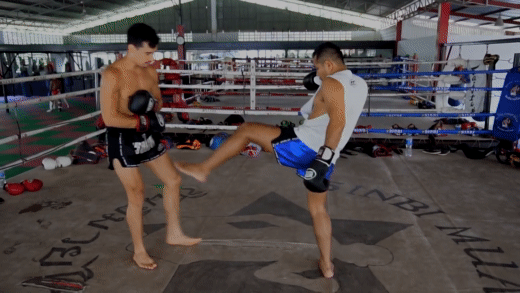
Front kicks are the longest weapons available in unarmed striking and can be used in various ways. The lead front kick often plays the role of a foot jab and keeps opponents at range. Taller fighters, in particular, must learn how to use it as a jab and maintain distance.
The lead front kick can also deal serious damage if the toes are dug in correctly, and there have been more than a few body knockouts courtesy of a well-timed and well-placed front kick.
Rear front kicks are thrown with more power and, more often than not, used in offense, unlike the lead-front kick, which is also used to intercept. The rear front kick is excellent at pushing the opponent away and resetting the action. Here are a few pointers for good front kicks.
- Lift your knee first, then extend the leg forward
- Push the hips forward; the power in the front kicks comes entirely from the hips.
- Aim to land with the ball on the foot
- Keep your close to your body
Roundhouse Kicks
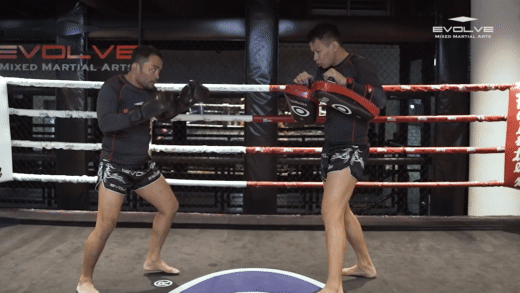
The most used kick in all martial arts has to be the roundhouse kick. Go here for a complete in-depth guide on how to throw roundhouse kicks. Here’s a quick summary:
- Roundhouse kicks fly in a horizontal semi-circular motion to the opponent.
- Roundhouse kicks can be thrown to the legs, the body, and the head
- There are different styles of throwing roundhouse kicks with varying degrees of speed and power to them.
Kickboxing Combinations
One of the hardest things for beginner kickboxers is to kickbox. They are always either punching with their hands or kicking with their feet, rarely combining both, which is very important for success.
There is nothing wrong with using only hand combinations in certain situations or throwing single kicks, but what makes kickboxing powerful are the fluid transitions between the two.
In boxing, there are two levels of attack: head and body, and this is why boxers have to rely more on footwork and angles to open up their opponents. Adding the legs as a viable target and a weapon opens up a third level and many more ways to target them.
The best way to confuse the opponent and maximize the chance of a successful attack is to change levels with every attack in a combination. Doing this will keep the opponent guessing, and you can be confident at least one of the strikes will land.
A staple combo in kickboxing that uses this fundamental principle is a jab-cross-left hook to the body-right low kick. If we break this down into levels of attack, it is head-head-body-legs.
You can use all boxing combinations in kickboxing. The only difference is that the range at which the fight is fought is different. Otherwise, all your basic boxing combos work just as well in a kickboxing setting. This is why we will focus only on combos that employ at least one kick, regardless of where it is in the combo. Feel free to train the basic punches and combinations at the same time.
Left Punch To Right Kick
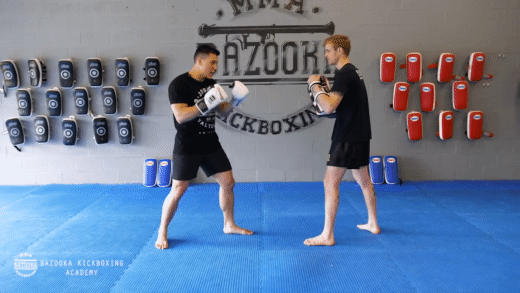
It’s vital to start chaining punches to kicks. The most basic method is to throw the low kick with the opposite leg from the punching hand. This results in the jab-right low kick and cross-left low kick combos. Practice these two a lot as they are the building block of throwing a kick after a punch principle. You can also change the straight punches to hooks.
Jab-Cross-Left Roundhouse Kick
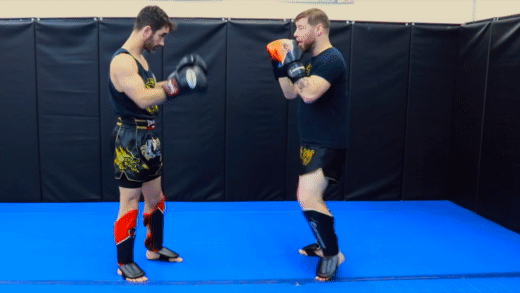
Instead of going with the hook to the body, use the left roundhouse kick to finish the one-two. This is one of the best ways to kick the liver, as the hands of the opponent are occupied up high to defend the punches.
Inside Low Kick-Jab-Cross-Right Low Kick
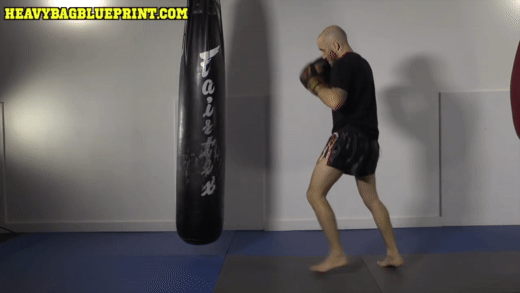
Usually, combinations don’t start with a kick, but using the inside left low kick is an excellent way to safely enter in range and land the one-two after that.
Add another low kick, this time on the outside of the opponent’s lead leg, for good measure. Changing from the legs to the head twice in the same combo will confuse even more experienced kickboxers.
Jab-Cross-Left Hook To The Body- Right Roundhouse
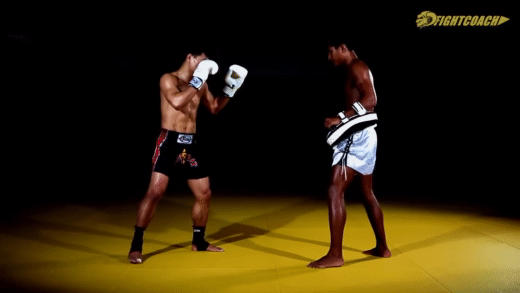
The Dutch kickboxing favorite. The punch portion of the combination is a staple of boxing. Still, the left hook also pins the opponent in place and loads his weight on the front leg, making it extremely difficult for him to defend the low kick.
Kickboxing Defense
Defense is as important as offense in fighting. Even though you cannot train it very efficiently by yourself, it’s still important to know how to defend against punches and kicks in kickboxing.
Blocking

Blocking is the easiest way to defend against punches and kicks. It also requires less energy and less skill than other forms of defense like evasion and parrying. Blocking means using your gloves, forearms, and elbows to block strikes at more vulnerable spots like the head and body.
The downside of blocking is that you still absorb some of the impact through the gloves, and against powerful hitters, this becomes a problem.
Kicks generate much more force than punches, and blocking with just the glove-like you can against a punch is not advised. Powerful roundhouse kicks are best blocked by using both hands.
You can read a full in-depth breakdown of how to block a punch here.
Parrying
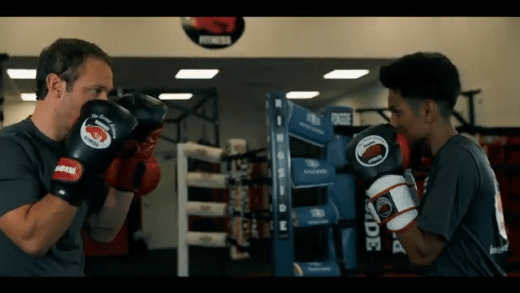
Parrying is done by deflecting the incoming strike in another direction. It is a better defense than blocking because it negates the impact. Parrying a punch or a kick always opens up opportunities for counterattacks.
Checking Kicks
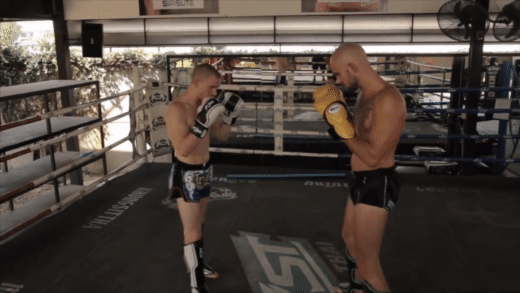
Checking kicks is blocking with your legs instead of your arms. The goal of a check is to block the incoming kick with the knee or upper part of the shin.
This clashes the harder bones of the defender against the weaker part of the shin or foot of the attacker. Unlike blocking, by checking a kick, you also hurt the attacker.
We’ve also done an in-depth guide on how to check kicks.
Frequently Asked Kickboxing For Beginners Questions
Is Kickboxing Good For Beginners?
Kickboxing is as good as any martial art for beginners. It may be more suitable than MMA for someone with no experience in martial arts because, in MMA, you have to learn both striking and grappling. First, focus on one of the two domains, with kickboxing being an important part of MMA striking.
Is Kickboxing Hard For Beginners?
Like every other new sport or activity, kickboxing is hard for newcomers. Still, it is not more complicated than any other martial art. What may be a problem is the lack of good fundamental motor skills and basic fitness.
Kickboxing is a great way to acquire those skills; many people use it just for fitness. Still, if you are in terrible shape, you will struggle more to learn kickboxing-specific techniques.
If this is the case, beginner kickboxing classes may be exactly what you need to get in shape, but be prepared to work hard.
What Should You Know Before Starting Kickboxing?
If you’ve read the complete guide to this point, you know more than enough to start kickboxing and progress past the initial stages. You will also need basic equipment, like kickboxing gloves, shin guards, shorts, and a mouthpiece.
How Often Should A Beginner Do Kickboxing?
Depending on your overall fitness and gym schedule, I recommend getting three sessions per week as a beginner. Less than that will mean painfully slow progress, which may cause you to quit, and training more may fatigue you too much in the early stages. If 3 is too much, then 2 sessions are still good, but training less than that is unlikely to make you better.
Summary
Kickboxing, as a modern combat sport, aims to produce fast and exciting stand-up battles with non-stop action. If you want to learn this striking style, you must be prepared to do a lot of punching and kicking.
You will need to develop good cardiovascular and muscular endurance to be successful in the ring or sparring.
As a beginner, there is no need to learn all the advanced techniques and concepts of the martial art, so I advise picking up the things provided in this guide, learning them one by one, and then combining them. And most of all, find a gym and start training there.

